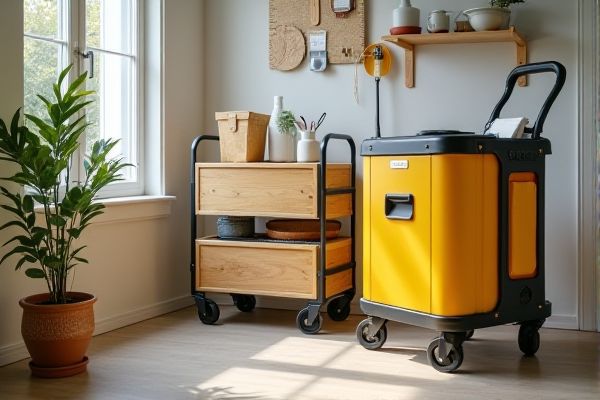
Choosing between a utility cart and a dolly depends on your specific hauling needs; utility carts offer versatile storage and easy maneuverability with multiple shelves and handles, while dollies provide robust support for heavy or bulky items through a flat platform and sturdy wheels. Discover which option best enhances Your moving or transporting efficiency by reading the full comparison in this article.
Table of Comparison
| Feature | Utility Cart | Dolly |
|---|---|---|
| Primary Use | Transporting multiple items easily | Moving heavy objects or boxes |
| Design | Multi-shelf, open frame with four wheels | Flat platform or vertical frame with two or four wheels |
| Load Capacity | Typically 200-500 lbs | Typically 300-1000 lbs |
| Maneuverability | Easy to maneuver in tight spaces | Best for heavier loads on flat surfaces |
| Common Materials | Steel, plastic, aluminum | Steel, wood, aluminum |
| Typical Uses | Warehouses, offices, gardening | Moving furniture, appliances, heavy boxes |
| Portability | Relatively lightweight | Usually heavier, less portable |
Overview: Utility Cart vs Dolly
Utility carts feature multiple shelves or compartments designed for transporting various items with easy access, ideal for organizing and moving supplies in offices, workshops, or homes. Dollies are flat platforms with wheels primarily intended for carrying heavy or bulky objects, such as appliances or furniture, offering stability and maneuverability during transport. Both tools improve efficiency in handling materials, but utility carts emphasize storage and sorting, while dollies focus on supporting weight and mobility.
Key Differences Between Utility Carts and Dollies
Utility carts feature multiple shelves and enclosed sides for organizing and transporting smaller items, while dollies typically have a flat platform designed for heavy loads or bulky objects. Utility carts offer greater versatility for carrying tools or supplies, whereas dollies prioritize weight capacity and maneuverability. Understanding these key differences helps you choose the right equipment for efficient material handling.
Design and Structure Comparison
Utility carts feature multi-level platforms with enclosed sides, ideal for carrying various items securely, while dollies typically have a flat, low-profile base designed for heavy loads. The structure of utility carts often includes wheels with locks and handles for maneuverability, contrasting with the simpler, four-wheel design of dollies that prioritizes weight capacity. Your choice depends on whether you need organized storage or straightforward heavy lifting.
Weight Capacity and Load Handling
Utility carts typically offer higher weight capacities, ranging from 300 to 1,000 pounds, designed for transporting bulky and heavy loads across various surfaces. Dollies generally support lower weight capacities, often between 200 to 600 pounds, and are better suited for moving heavy items over short distances or tight spaces. Load handling on utility carts benefits from multiple shelves and enclosed sides for stability, whereas dollies rely on a flat platform or a set of wheels for straightforward, compact load transport.
Maneuverability and Ease of Use
Utility carts offer superior maneuverability with multiple wheels and ergonomic handles designed for easy steering over various surfaces, making them ideal for transporting heavy or bulky items with minimal effort. Dollies typically feature a simpler design with two wheels and a flat platform, which may require more skill and strength to balance and move loads efficiently. Your choice depends on whether you prioritize ease of use and precise control (utility cart) or compactness and simple load sliding (dolly) in your tasks.
Best Applications for Utility Carts
Utility carts excel in transporting a variety of items across warehouses, offices, and retail environments, making them ideal for tasks that require moving multiple small to medium-sized objects simultaneously. Their open design and multiple shelves provide easy access and organization, enhancing efficiency in inventory management and maintenance operations. Your choice of a utility cart ensures versatility and convenience when handling diverse loads, beyond what a dolly typically supports.
Ideal Uses for Dollies
Dollies are ideal for moving heavy or bulky items such as appliances, furniture, or large boxes, providing stability and ease of transport on flat surfaces. Their low-profile platform and sturdy wheels make them perfect for navigating tight spaces and transporting loads over short distances quickly. If your task involves frequent lifting and shifting of heavy objects, a dolly can significantly reduce strain and improve efficiency.
Durability and Material Considerations
Utility carts typically feature sturdy steel or heavy-duty plastic construction designed for long-term use and resistance to wear and tear, making them ideal for transporting heavier loads over various surfaces. Dollies are often made from metal or reinforced plastic with a simpler design focused on mobility and compactness, prioritizing ease of maneuvering rather than rugged durability. Your choice should consider the material strength and durability required for the specific tasks and environments where the cart or dolly will be used.
Cost Comparison and Value
Utility carts typically cost more upfront than dollies but offer greater versatility with multiple shelves and higher load capacities, making them ideal for various tasks. Dollies, with lower initial costs, provide efficient mobility for heavy or bulky items but lack the storage features of utility carts. Evaluating cost versus value depends on specific usage needs, with utility carts delivering long-term benefits for frequent, diverse applications and dollies excelling in short-term, heavy lifting scenarios.
How to Choose: Utility Cart or Dolly
Choosing between a utility cart and a dolly depends on the nature of the load and type of maneuverability required. Utility carts offer multiple shelves and are ideal for transporting small to medium-sized items over smooth surfaces, while dollies excel at moving heavy, bulky items like appliances or furniture with better stability and often feature straps or a flat board. Assess load weight, terrain, and frequency of use to determine if the versatility and storage capacity of a utility cart or the strength and simplicity of a dolly best meet your moving needs.
 homyna.com
homyna.com